When I was a child, I cried often. I loved to cry. For me, it felt so good to cry, to feel my emotions and release them, to be free of them.
Then, when I was a teenager, I suddenly couldn’t cry. I’m not sure when it started, or how, or why, but suddenly, mysteriously, I couldn’t cry.
I remember when my grandfather passed away, I was astonished and shocked that I couldn’t cry. I loved my grandfather so much, and I was deeply sad that he’d passed, but I couldn’t cry at all. Why couldn’t I cry, even at something so sad? Was I really grieving if I couldn’t cry? Was there something wrong with me? Was I broken?
It was like that for about ten years. I couldn’t cry even if I wanted to, and I did want to. It wasn’t like I suddenly thought crying was stupid, or effeminate, or something like that. I just seemed to be physically incapable of crying.
Then, in 2015, something changed. I was training at what is now called the Monastic Academy, and I met Dr. Doug Tataryn, creator of the Bio-Emotive Framework.
He was visiting for a month as a co-worker at the time. I was in a new role, the assistant to my teacher, Soryu Forall. This is a very important position in a monastery: you manage the teacher’s schedule, who they speak to and when and why, and try to make the teacher’s life as smooth as possible, for their benefit as well as the whole monastery. I took it very seriously—too seriously. I was making myself anxious with stress over what now seem like relatively minor tasks. Although I had always been prone to anxiety, this situation made me unusually anxious, to the point of nearly having a panic attack.
Soryu asked Doug to work with me, to see if using the Bio-Emotive Framework might help me calm down and process my emotions.
Doug and I went into a private room, where I literally laid down on a couch while Doug talked to me. I remember everything in my body felt terrible, everything hurt and it seemed like I was dying, like the world was ending, like I was suddenly in hell. Doug asked me what was happening, and what I was feeling, and led me through the technique for processing emotions with the Bio-Emotive Framework, the NEDERA Process.
I don’t remember the conversation very well, as I was very disassociated and not thinking or feeling clearly, except for parts of it that were quite personal. However, I can tell you that as we went through the NEDERA Process, something changed in my body. I remember this very clearly. It was as if my left leg and right arm were lifted out of hell and into the normal world I was used to living in. My right leg and left arm and torso and head were all still in the hell of emotional activation and anxiety I’d found my way into, but part of me was out. There was relief and freedom in that, and a sense that I might not always be trapped in hell.
Doug’s framework and technique helped me get through that terrible day, and that chapter of my monastic training. At the time, I wasn’t quite sure what he’d done. It felt like magic. But after that, I made every effort I could to learn more about the Bio-Emotive Framework and the NEDERA Process, so that I could learn to do what Doug had done for me, for myself and for others.
In 2019, I participated in the Bio-Emotive Retreat at the Monastic Academy, and I got to learn more about Bio-Emotive from Doug, his wife Darlene, and his daughter Ali (Hoji). I learned about the technique and how it works, got to watch them facilitate others in the technique, and practice it myself. That summer, I did the NEDERA Process at every opportunity, until it became deeply familiar and instinctive. And after many years, I was finally able to cry again.
What is the Bio-Emotive Framework?
The Bio-Emotive Framework is like an expansion pack for Gendlin Focusing, developed by Doug Tataryn, designed for emotional processing and release. The NEDERA Process is the technique for applying the Bio-Emotive Framework to resolve emotions. In this post, I’ll describe the theory behind the Bio-Emotive Framework, share how to do the NEDERA Process, and point you to resources where you can learn more.
One of the main conceptual underpinnings of the Bio-Emotive Framework is the concept of the triune brain. The theory was proposed by neuroscientist Paul MacLean in the 1960s and suggests that the brain can be divided into three parts, which are responsible for different functions. These parts evolved as distinct layers over time, and correspond to different stages in our evolutionary history: the reptilian brain (basal ganglia), the mammalian brain (limbic system), and the human brain (neocortex).
When I first heard of the triune brain theory from Doug, it reminded me of my liberal arts education, because Plato talks extensively about the tripartite soul in his dialogues.
Scientifically, the triune brain has been criticized and arguably disproven as an evolutionary theory—but for our purposes, it is less a theory of how things are, and more of a pragmatic, phenomenological model for orienting towards your experience. In Burbea’s parlance, we can use it as a way of seeing.
According to the triune brain theory, the first layer of the brain is the physical or reptilian brain. This governs our autonomic nervous system: breathing, heartbeat, digestion, etc.
This is just speculative, but my sense is that this is where what you might hear people referring to as the “wisdom function” comes from. There are significant contemplative practices that have to do with the abdominal region (the lower dantien in Daoism or the hara in Japanese Zen).
Then there’s the emotional brain, which is located in the heart area. This is the emotional or energetic heart center, in the center of your chest, not the physical heart, which is (typically) located in the left side of your chest. The emotional brain governs our emotions, memories, our relationships with other people, status, etc.
Finally, there’s the neocortex, the intellectual brain, which governs language, thinking, logic, abstract reasoning, mathematics, etc.
Another fundamental concept in the Bio-Emotive Framework is alexithymia. Alexithymia is a condition where people have a hard time putting words to their emotions and feelings. We might also refer to it as emotional illiteracy.
Doug claims that alexithymia is endemic in our culture. As a common example of this, it happens very commonly to me that I will ask someone how they are feeling—what’s their emotional experience like right now?—and they will say something like “Oh, I’m feeling that that situation with my brother-in-law is so unfortunate, he really shouldn’t have…” Which tells me what they’re feeling something about, but not what they’re actually feeling emotionally (sad? angry? frustrated? alone?).
From the perspective of the triune brain theory, this means that the intellectual brain is disconnected from the mammalian brain, such that people cannot put words to their experience—which is a necessary part of feeling and processing your emotions. According to the Bio-Emotive Framework, if you learn to put words to your emotional experience, you can fully feel, express, and process your emotions. That’s where the NEDERA technique comes in.
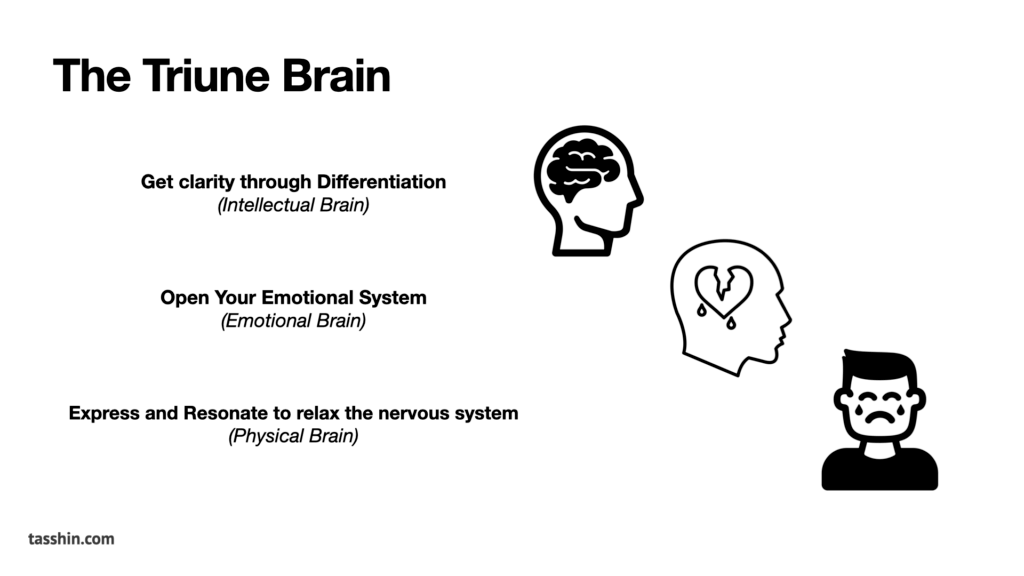
Adapted from a Bio-Emotive Handout from Doug Tataryn
How to Do The NEDERA Process
The NEDERA Process is a little bit like playing the video game Hades. In Hades, you play Zagreus, the son of Hades, trying to escape from the underworld.

You have to go through a series of levels—Tartarus, Asphodel, Elysium, and the Temple of Styx—in sequence before you can escape the underworld.

NEDERA is like that, but with the triune brain. When you want to process your emotions, you start with the intellectual brain, then proceed to the emotional brain, and then to the physical brain. (And just like in Hades, there’s also a final boss, feeling beliefs, but we’ll talk about these more later.) If you process each of these levels in sequence, you get to emotional release. Then, just like in Hades, and just like when I first tried Bio-Emotive, you’ve escaped from hell.
The acronym NEDERA stands for Notice, Experience, Differentiate, Express, Resonate, Resolve, Take Action and Update.
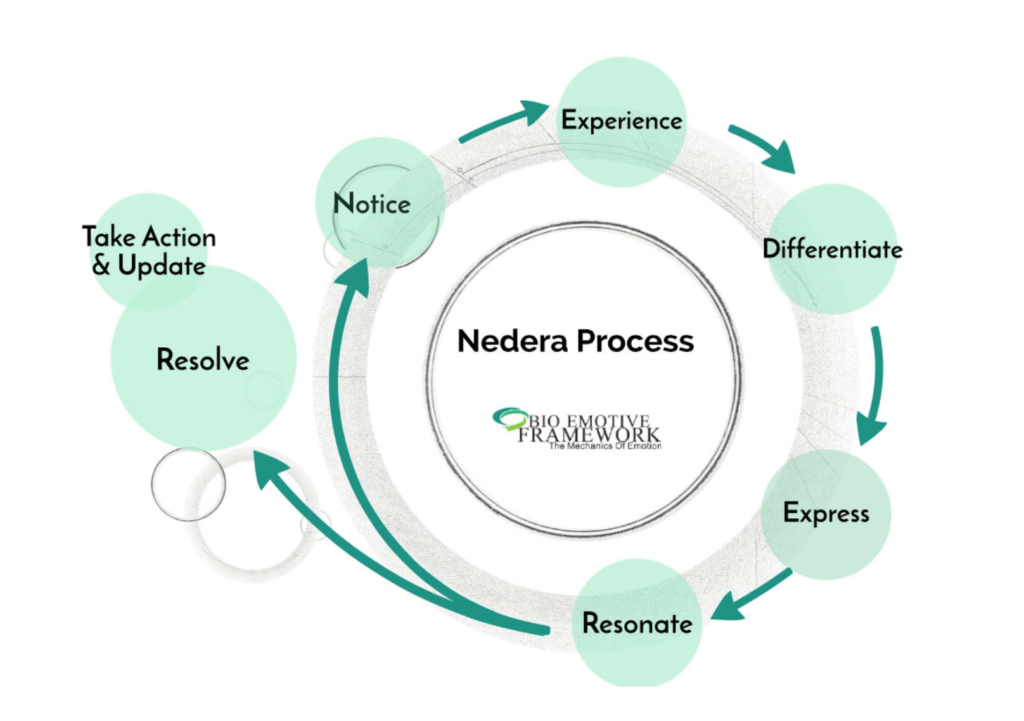
Diagram of the Nedera Process from The Nedera Guidebook
Notice
First, you have to notice when you’re emotionally activated or triggered. The heart is always feeling something, and there are almost always interpersonal feelings when we are around people. What you want to look for are things like having strong sensations in your chest or mouth area, unusual muscle tension, trouble breathing, looping thoughts, etc. If you notice you are emotionally activated, that’s a great cue to reach for the NEDERA Process to surface and resolve your emotions!
Experience
Experience the emotion. Emotions are centrally located in the chest, stomach, neck, and face, and then radiate outwards. Take time to feel that region of your body, to feel your emotions. Locate where exactly your emotions are present, and what they feel like, qualitatively.
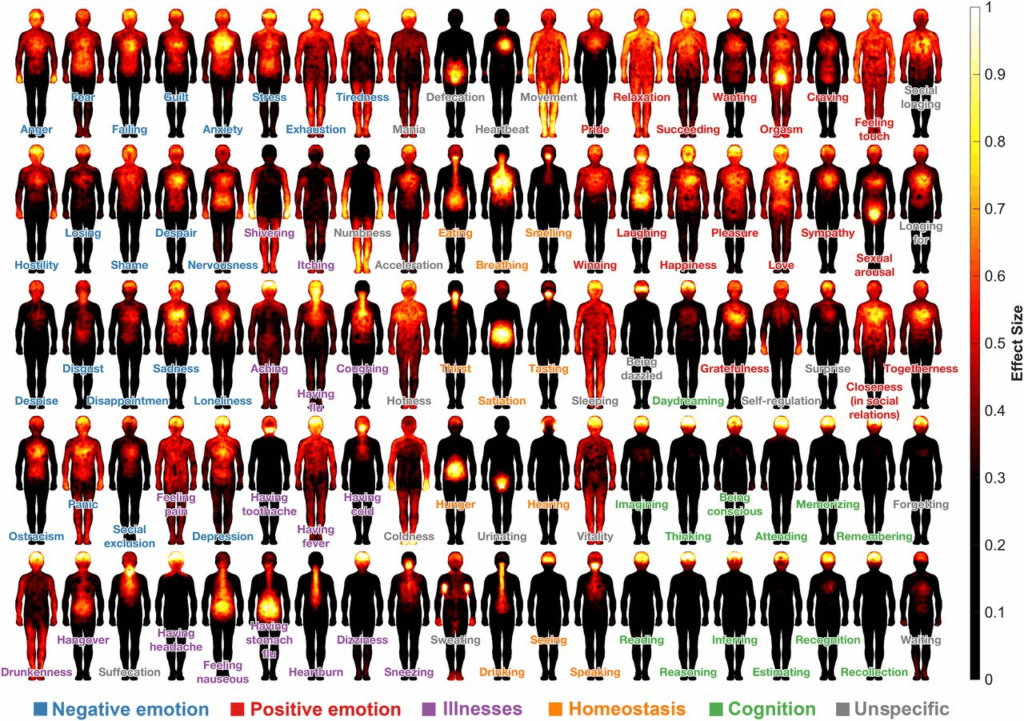
Bodily feeling maps, Maps of subjective feelings, Nummenmaa et. al 2018
As you begin to feel your body and do the NEDERA Process, you may notice various signals that you’re not ready to fully feel and resolve your emotional patterning.
There are a variety of mechanisms our body uses to repress our emotions and feelings. These include muscle tension, disassociation, distraction, sleepiness, and more. These can make it difficult to feel your emotions, to express your feelings, and to do the NEDERA Process to resolve your emotions and feelings.
If any of these experiences come up, consider honoring these signals, and easing off. You can always return and do more of the NEDERA Process later on. Use your best discernment to decide what to do.
Differentiate
In the Differentiate step, you focus on identifying what specifically you are feeling. You are finding the right words to describe your emotions and feelings. There are five levels of differentiation: your intellectual understanding of the situation, emotions, interpersonal feelings, core feelings, and feeling beliefs.
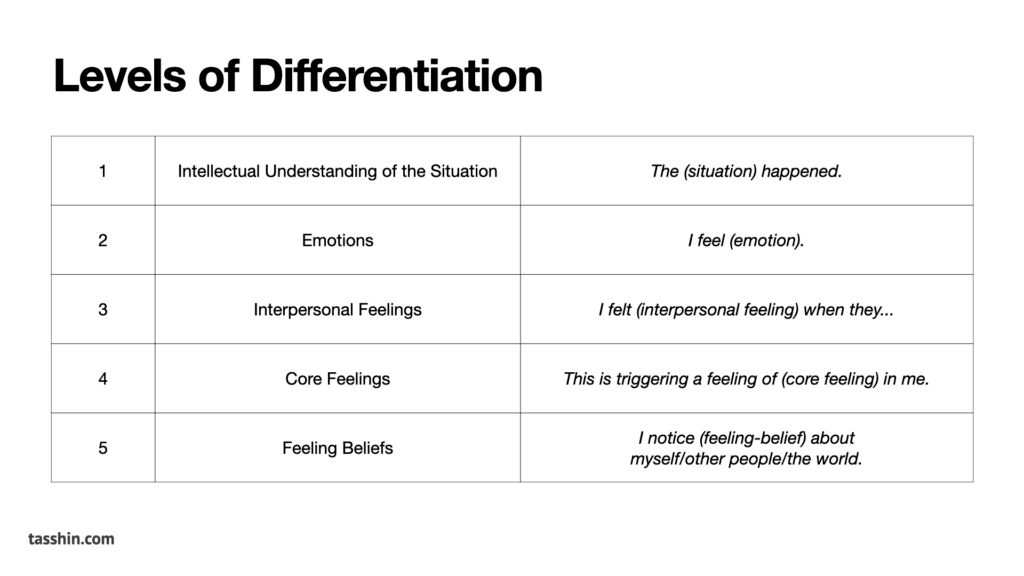
Adapted from a Bio-Emotive Handout from Doug Tataryn
We’ll return to each of these levels in more detail below.
Express
As you differentiate what you are feeling, you express it by speaking it out loud. Verbalizing your emotions and feelings helps you to reconnect parts of your brain that are disconnected (your intellectual and emotional brain). Voicing your words and hearing them through your own ears is a way to re-establish that connection. It also gives you the experience of being allowed to say what you’re feeling out loud, something that many of us didn’t have or were forbidden.
Resonate
As you express your feelings verbally, feel your body. You are looking for resonance with the statements you speak. Resonance is the emotional brain’s equivalent of truth.
Bring awareness into your body, and watch how it responds to what you’re saying. Feeling statements that are true for your emotional brain will resonate with the felt sense that you’re experiencing in your body.
If what you are feeling in your body changes dramatically as you speak your statements, if you start crying or laughing, that’s a sign of resonance. If your body stays the same, what you’re saying isn’t resonating, and you may need to return to the differentiation step to find different words to express your feeling.
It’s just like watching an actor. Sometimes, the acting in a film or television show isn’t very good. Their dialogue falls flat, and doesn’t feel very believable. On the other hand, there’s a reason incredible actors win awards—their performances are deeply believable, and remind you of what it means to be alive as a human in this world.
As you’re expressing your emotions and feelings in the NEDERA process, pretend you’re an actor who’s playing you in your life, giving a monologue as they’re having an emotional response to your feelings and situation. Really play it up—let your body, breath, and voice get involved in the process.
If, as you express yourself in a fully involved way, as if you were an actor in a movie playing your part, your words still fall flat, they probably aren’t resonant for you or reflective of your experience, and you’ll have to try on different words until they do resonate. But if and when they do resonate, what felt like acting will suddenly feel very real, and you may very well find yourself sobbing suddenly.
Resolve
When you use NEDERA, you are steering towards a release through crying. If you differentiate and express your emotions in a way that resonates for you, you will cry. At some point, the crying will come to an end on its own. You will have a sense of completeness, having cleared the difficult emotions, and feel at peace and ease. At this point, you have resolved your emotions.
If you haven’t yet released and resolved your emotions, cycle through experiencing, differentiating, expressing, and resonating your emotions and feelings, until you reach that point.
Take Action and Update
Sometimes, having processed your emotions isn’t enough. Having felt through what you’ve been feeling, you realize you need to make a change. If your emotions and feelings are asking you to act on their wisdom, take action on them. For example, this might look like having a difficult conversation with someone, discerning and setting a boundary, or making a major life change.
The Five Levels of Differentiation
The Bio-Emotive Framework gives a precise taxonomy to our emotional world. This includes five levels of differentiation: the story about your situation, emotions, interpersonal feelings, core feelings, and finally, feeling beliefs. Working through these in order helps you intellectually understand what you are feeling, open your emotional brain to your experience, and open your physical body to processing and resolving your emotions.
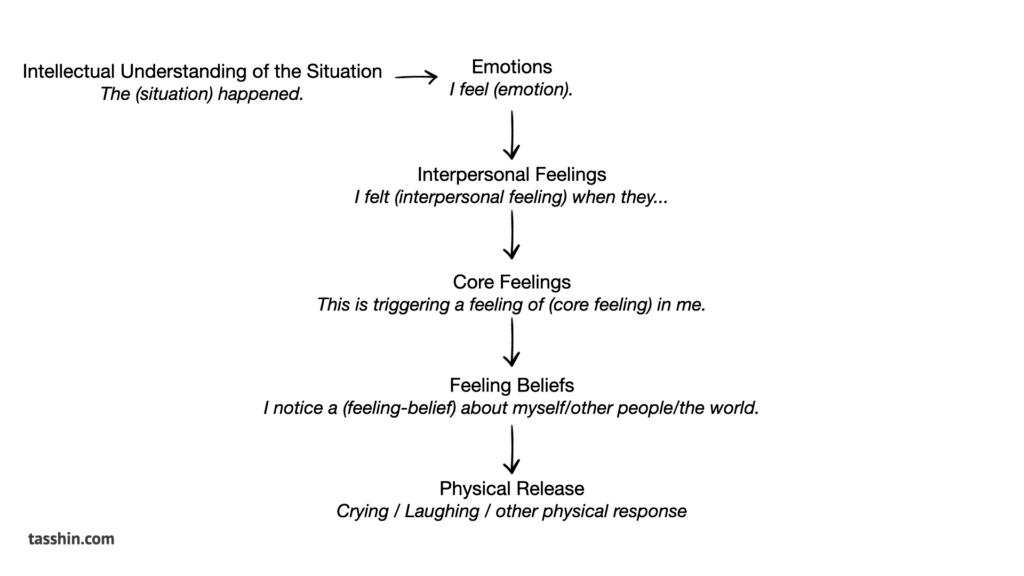
Situations
Once you notice that you’re emotionally activated, you start from the top, from the head, with your intellectual brain. You aim to tell the story of what’s happening for you, in a way that feels resonant and complete.
I think of this as going into talk therapy mode. You’re telling someone patient, empathetic, and kind about what’s happening for you. They’re listening carefully, and they really want to hear how you see it, what your experience is like.
So you tell them! You speak what you’re experiencing, as you intellectually understand it, out loud. This might sound something like this: “Oh man, I was with my friend earlier and they said this thing and it really pissed me off and I was just totally, totally messed up that they said this thing to me because it reminded me of this other thing that my father said six years ago.”
Often, the story we have is very complicated and nuanced, and could be drawn out in great length. In my experience, you really want to take the time to do so. You don’t want to push away your stories—instead, you really want to honor them.
If you’ve meditated a lot, this step can be difficult. Many styles of meditation are about dropping our stories and narratives, escaping from the intellectual brain and getting into our direct, embodied experience of the world. At this stage, we actually want to take our internal narratives seriously. You want to take some time to surface and believe the stories you have about the world.
When you’ve done so, when you’ve articulated your stories clearly and expressed them out loud, there’s often a feeling of satisfaction—like, “yep, that’s really how it is.” It’s not yet the feeling of emotional resolution—all of your emotions are still present, you’re still activated about the thing you’re upset about, and you’re still experiencing your world as having a “problem” (something that may fade and dissolve after you go through this process). But there is a satisfaction in having clearly stated what your experience is like. That’s because you are taking yourself seriously, you are loving yourself enough to notice and express what your experience is like.
After you’ve articulated what your story is about what’s happening for you, it helps to distill this story into a brief phrase that encapsulates or summarizes the story: “She yelled at me” or “They fired me” or “He left me.” You will use this phrase as a stem as you proceed through each step of the NEDERA Process, and add other phrases about your emotional landscape.
Emotions
Once you have expressed your story intellectually, you want to drop into the emotional brain. At this point, things will “stop making sense.” What the emotional brain feels will likely not make sense to the logical, intellectual brain, which typically sees the contents and feelings of the emotional brain as irrational, nonsensical.
Your intellectual brain might respond to the feelings of the emotional brain with phrases like “Stop feeling sad, things will be ok!” or “Why are you angry? There’s no reason to be angry.”
To successfully feel and process your feelings, you will need to set aside any judgements your intellectual brain has of what you’re feeling emotionally, and honor the emotional brain’s feelings on its own terms. Everything you are feeling is valid and worthy of being respected and felt, even if your conscious mind says otherwise.
As you listen to, feel, and honor your emotional brain more and more, you will find that it has a wisdom all its own. As Pascal said, “the heart has its reasons that reason knows not.”
Most of us talk about emotions and feelings interchangeably, but the Bio-Emotive Framework makes a distinction between emotions and feelings.
Emotions are felt sensations in the body, which are genetically programmed. These are what psychologists call the Big Four: Happiness, Sadness, Anger, and Fear. They are the same across cultures, and even across species—other mammals have them as well.
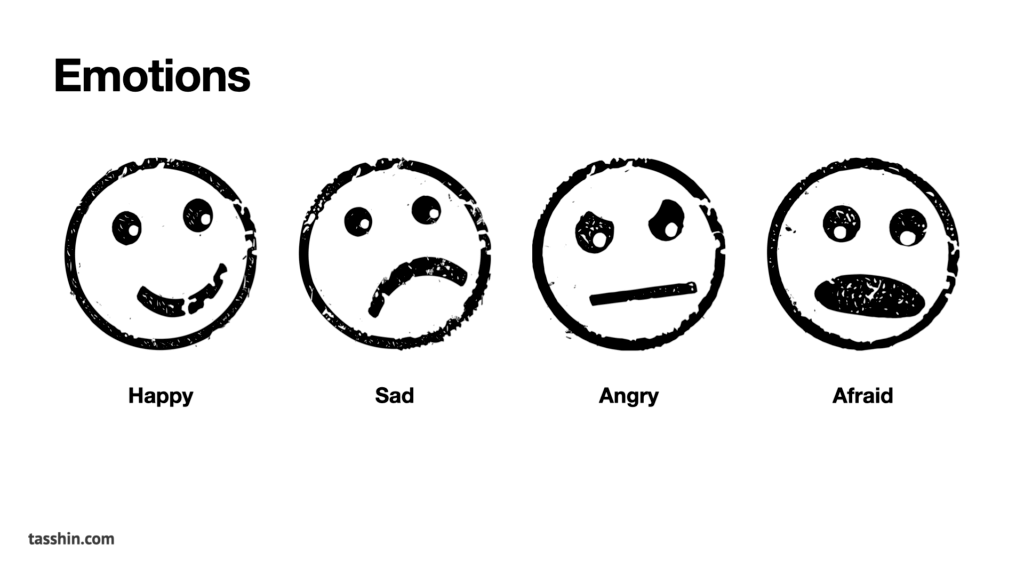
Adapted from a Bio-Emotive Handout from Doug Tataryn
Feelings are our emotional brain’s best guess at what’s going on between us, other people, the world around us. Am I respected? Do I fit in? Do people care about me? Do I matter?
At each stage in the emotional brain, you try to make a guess as to what you’re feeling, and then you say it out loud.
Typically, when we start this process, the intellectual brain has a lot of filters against us feeling your feelings. And so if you say it out loud, ideally multiple times, then you start to notice whether what you’re saying feels true for you.
At each stage, you want to check for resonance. Listen to your voice—does it sound different? Feel your body—does it feel different? When you speak it, does it feel right, emotionally? How does the world seem to you—has it changed?
So, to start, you take a guess as to which of the four emotions you might be feeling, and say that out loud. You say your story stem, and add “I feel angry” or “I feel sad” or “I feel afraid” or “I feel happy.” You say that out loud, and wait a few moments. You feel your body, and see if what you’re saying resonates.
Typically, when you start, it helps to do this a few times with each phrase that you say. You guess that you’re feeling angry, and then you say that out loud. You pause for a few seconds to feel your body and check for resonance. Nothing resonates the first time, but you try again—saying “I feel angry” out loud, waiting a few seconds, and then you notice that your jaw twitches. Then you try again, one more time, and after you say “I feel angry,” your fist clenches and your chest jumps with anger.
Or, maybe you notice you’re not feeling any responses at all after a few tries, so you guess something different—“I feel afraid”—and notice after a few tries that that stem has resonance for you, that your throat quivers and your stomach drops when you say you’re feeling afraid.
Whatever emotion you find, add it to your sentence, after your story stem: “He left me, and I feel angry.”
Interpersonal Feeling
Once you are clear about what emotion(s) you are feeling, you move on to the interpersonal feelings. These are relational feelings—typically with another person, but sometimes with a group, or society as a whole, or in some rarer cases, about your relationship with yourself (e.g., “I disrespected myself”). In any case, these are about relationships.
There is a practically infinite set of interpersonal feelings: “I feel betrayed,” “I feel abandoned,” “I feel hurt,” “I feel trapped,” “I feel disempowered.” There are also positive ones: “I feel trusted,” “I feel believed in,” “I feel loved.”
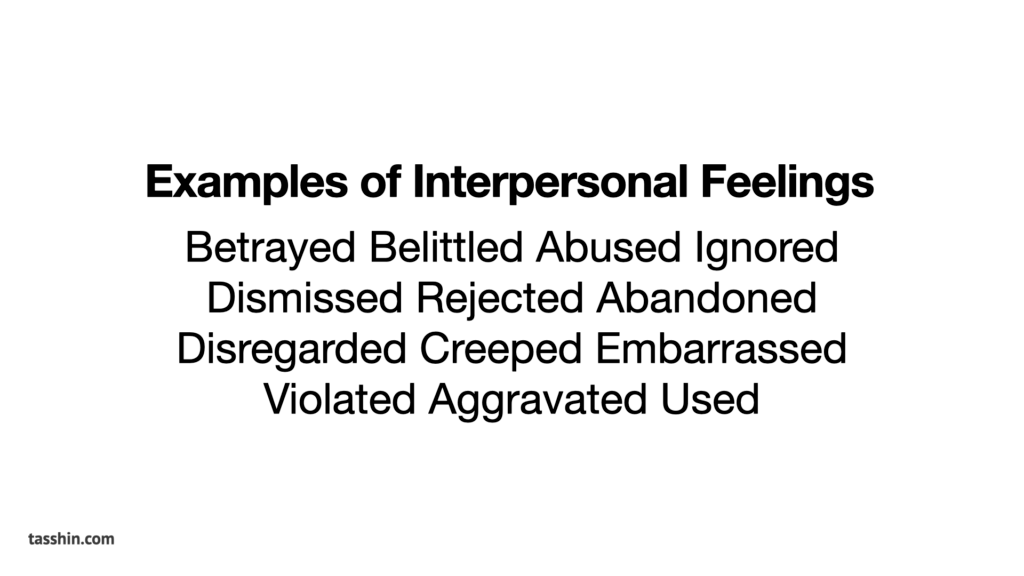
Adapted from a Bio-Emotive Handout from Doug Tataryn
You’ll notice that these mostly end in “-ed” in the English language. There are other examples (“I feel hurt”) but typically, these are how we tend to express a relational situation linguistically.
This interpersonal feeling colors whatever the primary emotion is. Saying that you feel angry and betrayed is qualitatively different from just angry, or feeling angry and abandoned.
Again, at this level, you take a guess, say it out loud, and check for resonance. Say your story stem, your emotions, and your guess as to your interpersonal feeling: “He left me, I feel angry and rejected.” Check for resonance. Does your voice sound different? Do you feel different? Does the world seem, look, or feel different when you say it?
When you find what interpersonal feelings are present for you, you append that to your growing sentence, alongside the story stem and your emotions: “He left me, I feel angry and betrayed.”
Core Feelings
Once you’ve found what resonates for you, you can move on to the core feelings. These are feelings about ourselves, who our emotional brain believes we believe are.
Unlike the interpersonal feelings, this is a bounded, finite set of specific feelings. According to the Bio-Emotive Framework, there are nine core feelings, each of which has a negative feeling and a positive complement:
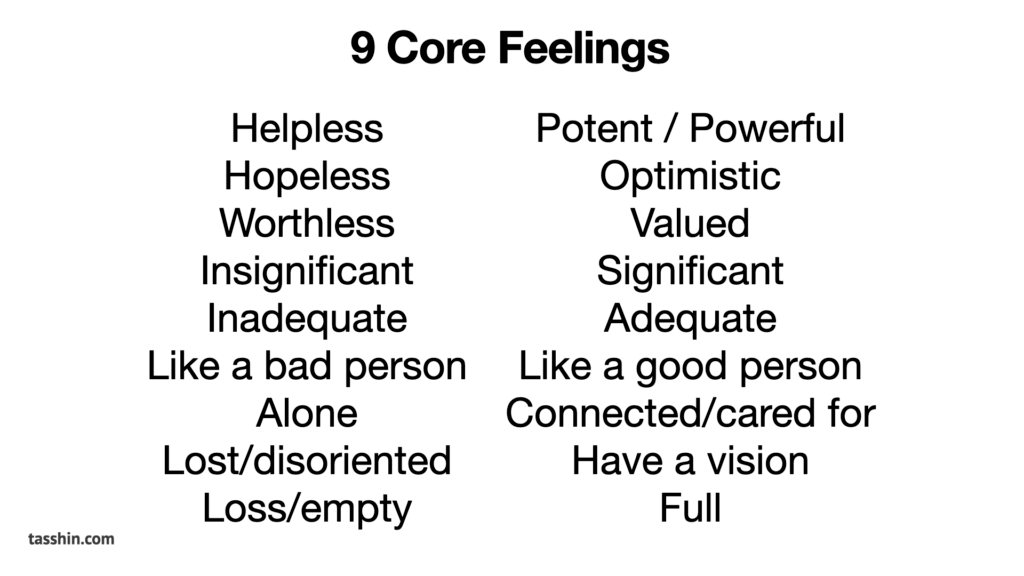
Adapted from a Bio-Emotive Handout from Doug Tataryn
Again, take a guess as to which of these core feelings you might be feeling, and say it alongside your growing sentence about your experience: “He left me, and I feel angry and betrayed and alone.” Then, pause for a few seconds, feel your body, and check for resonance. If it resonates, add it to your sentence. If it doesn’t, try something different.
When I first heard this list in 2015, Doug had us verbally speak each of the negative forms of the nine core feelings, and say them out loud several times, checking for resonance. We wrote numbers next to how intense each of these were for us.
Typically, people have something like one or two or three core feelings that they tend to feel frequently, which are sticky and recurring for you, almost like hotspots. Of course, you’ll probably go through the whole range of human emotional experience and feel any of these at any given time, but most people will have a couple of hotspots.
For example, I feel alone a lot of the time. It’s almost like the furniture of my emotional experience—it’s just seemingly always there. I can say the phrase “I feel sad and alone” and that will almost always cause me to cry.
As you go through this process, you’ll probably find a similar phrase with these core feelings that causes that for you. Maybe you feel inadequate a lot of the time, or like a bad person. (If you feel “bad” or “good,” this is how you feel about yourself morally, rather than being uncomfortable or comfortable.)
When you learn these core feelings, it’s a tremendous upgrade in your emotional experience. You suddenly have the keys to the kingdom, the words to describe your emotional world in a way that’s accurate and resonant.
However, be careful with these words, and who you say them to! Words like “hopeless” and “worthless,” while reflective of our emotional brain’s reality, are quite intense. It’s totally fine to share these feelings with a therapist, trusted friend, or family member. But you may want to exercise caution before sharing them with people you’re less intimate with, or with whom your innermost feelings aren’t welcome, or won’t be received lovingly.
For example, you probably wouldn’t want to share your core feelings with your boss or a co-worker, at least in a traditional work environment. It’s usually fair game to share your emotions (angry/sad/afraid/happy) and interpersonal feelings (e.g. hurt/distrusted/supported) in these environments.
Usually, in my experience, when a reasonably mature adult hears your emotions and interpersonal feelings—whether they’re positive or negative—they will respond in a way that is surprisingly responsive, and helpful. Sharing interpersonal feelings in particular can be very meaningful information for people to hear. Other people will often respond in kind, sharing their own interpersonal feelings in the relevant situation (“Oh, you felt betrayed! Wow! I felt abandoned! No way.”). This reciprocity in revealing emotions and feelings sets the stage for healing and reconciliation.
But there’s not always the relational space and context (or the emotional and psychological maturity) to respond accordingly with the core feelings, so use your discretion about who you share your emotional world and in particular your core feelings with.
Feeling Beliefs
There is one final level in the Bio-Emotive Framework: feeling beliefs. These are connected to, but not quite the same as, the emotions, interpersonal feelings, or core feelings. These are beliefs that your emotional brain has about yourself in relationship to the world, about the nature of the universe.
Typically, the sticky core beliefs that are like hotspots for you—like “alone” for me—will have a feeling belief associated with them. For example, “I am alone, and no one will ever love me” is one that I found for myself, which made me sob and sob and sob when I first found them.
Feeling beliefs are almost always very, very simple. The intellectual brain is complicated—the emotional brain is simple. Rather than something like “I’m not very good at things and people won’t approve of me because of that fact,” a feeling belief will likely sound more like “I’m bad and nobody will ever love me.”
When you find the feeling belief, add it to your growing sentence about your emotional experience. For example: “He left me, and I feel angry and betrayed and alone, like nothing good will ever happen again.”
Nearly every modality of therapy or self-therapy that I’ve encountered has something like these: exiles and their burdens in Internal Family Systems, schemas in schema therapy, consolidated memories in coherence therapy—and, to my mind, these are pointing to the same thing as saṃskāras in Buddhism.
Whatever you call them, these are patterns we picked up at some point, beliefs about ourselves and the world, that made sense as an adaptive learning at the time, but are no longer accurate or useful to us, and are instead causing ourselves and others suffering.
When you find a core feeling, it can be tricky to find the feeling belief associated with it. It is helpful to have another person, ideally an experienced facilitator, to guess and suss out what your feeling belief might be.
But if you repeatedly find a core feeling when you process your emotions, you might ask yourself, “What is it that I believe about myself and the world here? What seems true to me about myself and the universe?” You ask yourself these questions, not intellectually, as a problem to be solved, but asking your heart—what do you feel, what do you believe, emotionally?
From an Internal Family Systems perspective, the Bio-Emotive Framework and the NEDERA Process give you a reliable way to unburden your exiles; from a coherence therapy perspective, it gives you a reliable way to do memory reconsolidation.
If you can find and articulate the feeling belief, alongside the other levels of differentiation—the story about your situation, emotions, interpersonal feelings, and core feelings—then this will provide a deep release, such that you can process and let go of the feeling belief.
On Crying
The NEDERA technique is really about steering towards crying. In order to truly process your emotions, you need to cry. However, the Bio-Emotive Framework makes a distinction between healthy and unhealthy crying.
You may have seen someone caught in the spiral of unhealthy crying before. They just sob and sob and sob, for hours and hours and hours, maybe even days and weeks and months. There seems to be no end to their sobbing. Even if they stop crying, they still feel awful, depressed, and unhappy.
According to the Bio-Emotive Framework, unhealthy crying happens when the different layers of the triune brain are disconnected. When the intellectual brain has no understanding of the emotional brain’s experience, you can’t put words to it, express your emotions and feelings, and resolve them physically. Instead, you’re just looping in triggers and activations.
Healthy crying happens when the triune brain is integrated, when you can put specific, accurate words to describe your experience, express them out loud, and then feel and resolve your emotions and feelings through crying and release.
This kind of crying feels like it probably did when you were a kid—where you cried fully, and then afterwards, you felt better. Healthy crying makes you feel clean and clear, like a bright sky filled with sunshine and rainbows after a rainstorm. Unhealthy crying, on the other hand, feels like a dark and cloudy storm that just won’t pass.
The Bio-Emotive Framework distinguishes multiple stages and degrees of crying, from a little flushing to full-on sobbing:
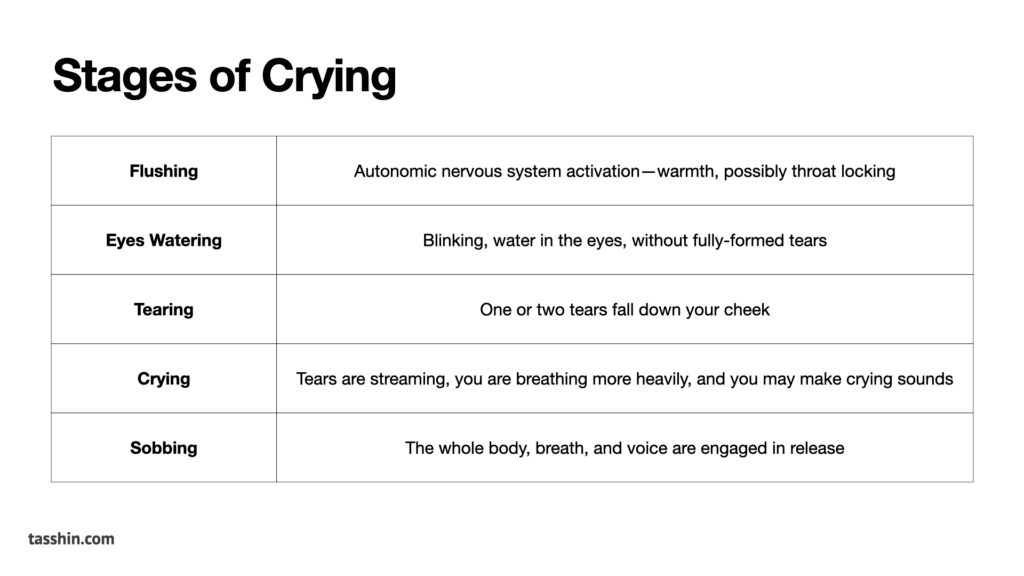
According to the Bio-Emotive Framework, the higher the stage of crying, the more release is possible. Accordingly, the best form of crying is full on sobbing and wailing. If the sobbing is paired with accurate, resonant statements about your emotions and feelings, you can clean out a tremendous amount of out-of-date emotional beliefs and trauma.
However, sobbing may not be possible for you. When I started doing Bio-Emotive and the NEDERA Process in 2015, it became possible to tear up a little bit. Gradually, over time, I started to be able to cry more and more—in intensity, frequency, and ease. Now, I am able to sob fully if my emotions and the situation calls for it.
Practice makes perfect, and as you do the NEDERA Process more and more, as it becomes easier and easier and you apply it to more situations that activate you emotionally, you will be able to cry more easily, and heal more of your emotional wounding.
Facilitation
In my experience, it’s easiest to learn the NEDERA Process by being facilitated by someone who already knows how to do it—whether it’s a therapist, a coach, or just a friend. You can learn the theory of the NEDERA Process by reading a post like this, but your nervous system will learn how to do it by interacting with someone else whose nervous system already understands how to feel, differentiate, express, and resonate with emotions and feelings.
Moreover, when you reach core feelings and feeling beliefs, being in the presence of someone else who is holding space in a kind, loving, attentive, equanimous and balanced way is tremendously grounding for your nervous system. Making eye contact during the process may be helpful for ensuring these benefits.
If you are being facilitated in the NEDERA Process, the facilitator will suggest phrases for you to say. This is a little weird, because typically they will prompt you by speaking phrases as if they were you—for example, saying “I feel angry and abandoned” when they guess that that is what you are feeling, but they are clearly not feeling angry and abandoned themselves.
They say this phrase as a prompt, so that you can try saying the phrase yourself. Try saying the phrases the facilitator suggests, at least two or three times, with a pause to feel your body and check for resonance in between. Do this even if their suggested phrase seems totally off. If it still doesn’t resonate after a few tries, you can say so, but really give the phrases a try.
When you find phrases of interpersonal feelings, core feelings, and feeling beliefs that are resonant, it can be helpful to remember them by writing them down. While of course the person doing the NEDERA Process can write them down, they will likely be emotionally activated and possibly overwhelmed, so in practice, it’s usually best if the facilitator writes them down, and shares them with the person being facilitated afterwards.
If you do a lot of practice with Bio-Emotive and the NEDERA Process, you may eventually be interested in facilitating other people in the process.
A lot of what you’re doing is just being there for someone else, making eye contact, and being a caring person while they process their emotions. But, optionally, you can also suggest phrases for the person being facilitated to try out to describe their emotional experience.
Eventually, you start to develop a lot of intuition about what you and others are feeling, and for the shape of their emotional experience. When I’ve done this, I’ll start to have a guess as to what someone else is experiencing, that usually seems surprising and unexpected to me, because the emotional experience may not be an experience I myself would be having—but these wild, seemingly out-of-left-field guesses often prove to be uncannily accurate. Through doing the NEDERA Process with yourself and others, your nervous system is developing its innate ability to attune to and resonate with other people and their nervous systems.
Conclusion
For me, when I’m in a distressed emotional state, it can feel like I’m in hell and it’s going to last forever. But when I do the NEDERA Process, I experience nearly instant relief.
Developing the ability to feel, differentiate, express, and resolve your emotions is incredibly powerful. It’s a natural process, that the Bio-Emotive Framework and the NEDERA Process helps us to re-learn, and re-discover. They may seem very complicated—it’s taken me quite a lot of words to articulate what the Bio-Emotive Framework is, and how to do the NEDERA Process—but it’s actually a very simple process once you get the hang of it.
Typically, people learn about Bio-Emotive and the NEDERA Process because they are having emotional difficulties and unresolved feelings. Once you’ve developed the ability to do the NEDERA Process, be sure that you use it with positive experiences as well—to express the positive versions of the core feelings when you feel them. Differentiating, expressing, and resolving your positive feelings will help you to enjoy your positive experiences more deeply and raise your baseline of emotional well-being. As you can imagine, this practice pairs well with loving-kindness meditation and the brahmavihārās.
Learning to do the NEDERA Process has made it a lot easier for me to meditate. It’s incredibly difficult to meditate when you’re emotionally activated. If you have learned and internalized the NEDERA Process, you can use it at the beginning of a period of formal meditation practice (or whenever you’re activated emotionally), and it makes it much easier to meditate and concentrate.
Learning how to recognize and resolve The Five Hindrances is necessary but insufficient as a meditator in the modern world. I’ve found self-therapy modalities have been an important complement to traditional methods from Buddhist practice and other contemplative traditions.
Becoming familiar with The Bio-Emotive Framework has also made it easier for me to understand other people’s emotional experiences, and to read other people, even when they’re quite different from my own. I believe that in a sane and healthy society, our natural emotional intuitions would be preserved and developed, honored and protected, but in practice that’s not typically the case in our society.
If you’ve read this post and found it helpful, I can’t recommend the official materials from the Bio-Emotive Team highly enough, especially their Self-Paced Course or any live trainings that they run. As of this writing, the Self-Paced Course includes one online meeting with Ali, in addition to the self-paced videos and reading materials. Interacting with someone who knows the NEDERA Process is extremely helpful—there’s only so much a piece of writing like this blog post can do.
I’ll always be grateful to the Bio-Emotive Framework and the NEDERA Process for helping me to regain this ability, and for showing me how to cry again. Rather than feeling like a stranger or victim to my emotions and feelings, I feel safe, at ease, and at home in my own emotional world.
May you feel, express, and resolve all of your emotions. May feeling your feelings bring you tremendous peace, safety, and joy. May you flourish in your life from a place of happiness and ease. ❤️
Thank you to Doug Tataryn for developing the Bio-Emotive Framework, and to Doug, Darlene, and Hoji for teaching it to me. I am grateful for your permission and blessing to publish this post. Thank you to Daniel “Ryūshin” Thorson for practicing Bio-Emotive extensively with me in 2019. Thank you to Ben Ratkey, Ryūshin, Eric Chisholm, Abi Ly, Malcolm Ocean, Qiaochu Yuan, and Jane Miller for reviewing this post and providing feedback.
More Resources
- Bio-Emotive 101: Journey Into the Emotional System (Self-Paced Course)
- All About Healthy Crying (ebook)
- The Nedera Guidebook: A Step by Step Guide to Processing Emotions (ebook)
- Inherent Healing Processes
- Podcasts on the Bio-Emotive Framework
- Bio-Emotive Framework: An Introduction (The Stoa)
- A Crash Course In Emotional Intelligence (ATTMind)
- Emotions in Meditation and Human Development (Emerge)
- Meditation, Emotions, and the Bio-Emotive Framework (Deconstructing Yourself)
- The Bio-Emotive Framework and We-Spaces with Hoji Alexandra Tataryn (Reach Truth Podcast)
